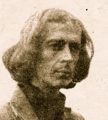LES BOUILLONS & BOUILLONS KUB

THE PAINTER AS AN INSTALLATION
Exhibition notes, December 2012, La Trancardière
This exhibition follows from ‘À travers champs’ (“Across the Fields”) the summer art event held at Les Bouillons, Orval sur Sienne in Lower Normandy. It was organised by the artist André, and ‘Arsor’ (the name implies ‘art-out’) an association of like-minded artists.
I was delighted when André asked me to participate as a living exhibit in the outdoor event, because I knew this would emphasise the evolving, temporal aspect of my painting rather than the finished canvas as an art-object or commodity.
As to why a seemingly traditional painter should be displayed alongside conceptual artists, it is entirely consistent with the philosophy of Arsor, which is to promote links among artists and society in general, and to release creativity in all kinds of contexts across different fields. In the work of André, such an everyday object as a ‘debouchoir’ (‘sink plunger’), which he considers representative of humanity itself, is a fitting symbol to unblock channels of understanding and expression.
Why do I paint plants? Because photosynthesis is the basis of culture. (Artists are allowed to make such unsubstantiated statements.)
Many painters, including myself in the past, have worked in the timeless, Olympian detachment of a studio. Here, one can work on a canvas, set it aside and come back to it, sometimes years later, or be occupied with several works in the space of a day. But for most of my painting career I have worked almost exclusively outside from direct observation.
The outdoors is the inverse of the studio: one is committed to a particular location, and subject to the vicissitudes of a particular time. Time becomes an integral part of the subject of the painting, and its requirements profoundly influence the technique and one’s whole approach.

I am exhibiting this particular painting as an art-piece that is part of an ongoing process. The canvas is the outcome of an extended experience in a particular space-time frame, but it embodies a past that will also define its future.
JOHN PEARCE, December 2012, La Trancardière

LES BOUILLONS, À TRAVERS CHAMPS AND BOUILLONS KUB

Les Bouillons, near Orval sur Sienne in Lower Normandy, is a manoir with extensive lands, jointly owned by members of the families Letteneur, Saussaye and Gemin. They have allowed me to paint there from time to time over the past thirty years. L’ancêtre (ancestor) Archille Tanqueray who first acquired Les Bouillons as a working farm was himself an artist, and creative talent of one kind and another has continued in the families. According to Julie Saussaye, l’ancêtre had acquired works by Jean-Léon Gérôme at a time when that once celebrated, academic painter and École des Beaux-Arts professor was becoming unfashionable. But interest in Gérôme revived, and l’ancêtre later sold his collection to the Louvre and was able to purchase Les Bouillons. (An exhibition of Tanqueray’s works was curated by André at Les Bouillons in September 2023).
In 2012 I was invited to paint at Les Bouillons as part of the outdoor event called ‘À travers champs’ (Across Fields) organised by one of the residents, Marc Gemin. Marc is also a conceptual artist, under the name ‘André’.
André’s art arose from his observation, in various industrial settings in which he worked as a metallurgist, that there invariably existed an alternative, subversive type of narrative, in behaviour and conversation, to the official and accepted. Since curating ‘À travers champs’, André has developed his studio into a space for individual art events, which he called “Bouillons Kub” (i.e. a stock cube) ironically recalling Britain’s prestigious White Cube. One of the first events in Bouillons Kub was ‘Réinventer la Roue’, a construction in recycled cardboard by the British artist Will Alexander.
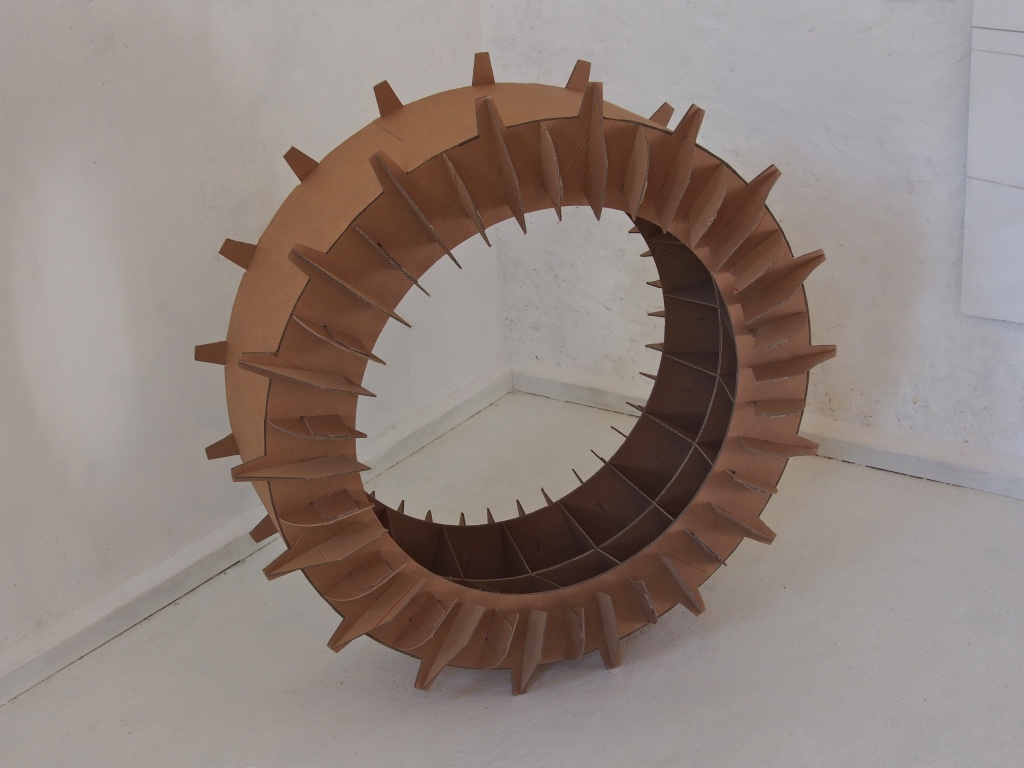


An early example of André’s artwork had come about when he was working in an iron foundry, and found time, and out of the way corners of the workplace, in which to quickly make paintings on discarded pieces of metal. On another occasion, working in a nuclear power plant, he persuaded the directors to allow him to mount an exhibition, and utilised items of protective clothing and other paraphernalia from the works. After agreeing to the exhibition, the bosses decided not to allow the public in after all, but the exhibition went ahead in the atrium in front of the head office and was seen by everyone in the workplace. André’s work makes use of everyday or ready-made objects and industrial materials. “Should the plastic artist be a producer of objects, on a par with an industrialist, an artisan in a productivist world? Or, more modestly, through their productions bring a questioning, another view?”

If he could be called a Dadaist, then perhaps André is a Dadaist with a conscience. He had often observed me painting on site at Les Bouillons, and understood that my practice, in some ways like his, had an aspect of site-specific performance, so he asked me to participate as a live on-site installation.
I agreed, but whereas most of the other artists involved spent a day setting up their exhibits, then had a few beers and went home, once I was installed I remained on public display for the duration of the event, in fact continuing to work on the painting long after the show ended.
À travers champs included various notable installations, one being a machine which when activated registered whether or not a ‘real artist’ was present. On the whole, however, Dadaists deem labour-intensive artworks meaningless. Did they feel my practice was self-evidently absurd, and therefore an ironic contribution?
To view, please click on the images in the following galleries:





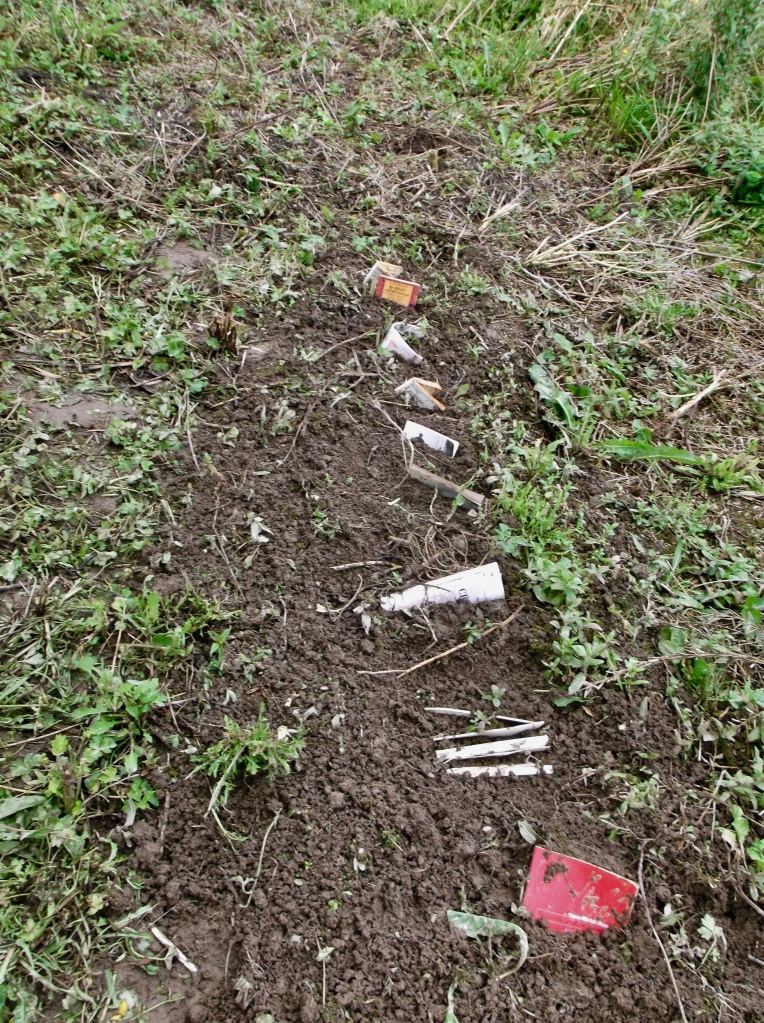

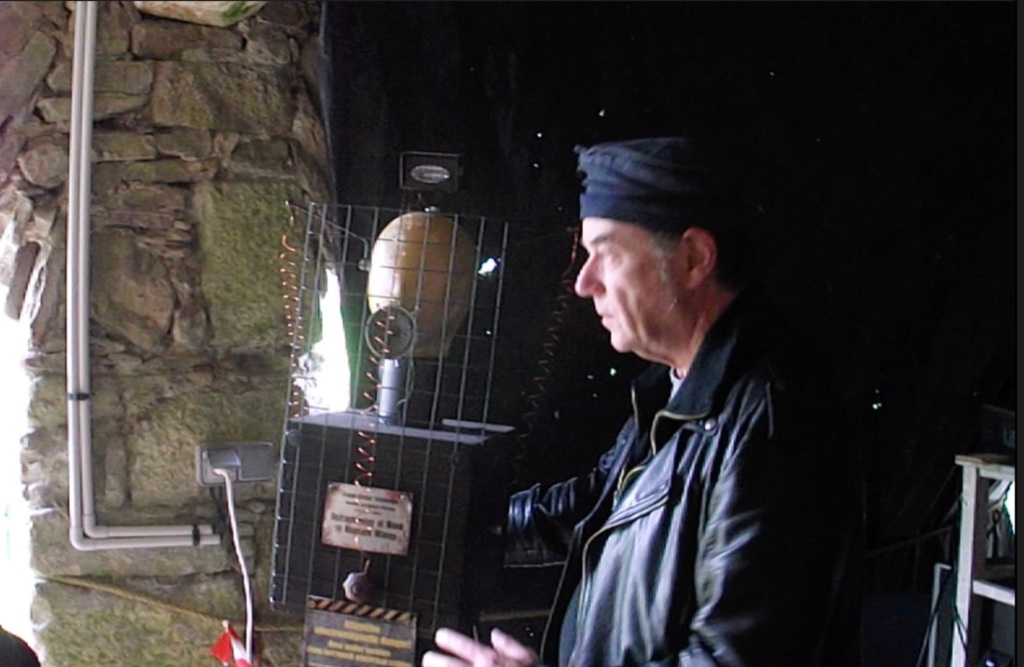


Glimpses of myself and other installations and events, in “à traverse champs” Les Bouillons, August 2012
The title ‘Solar Power’ occurred to me during my work on the picture as I became aware of the ineluctable growth of a new shoot from the chestnut stump in the foreground, wrongly pronounced dead. The massive barn in the background was also meant for storing sunlight in the form of grain, hay or straw.
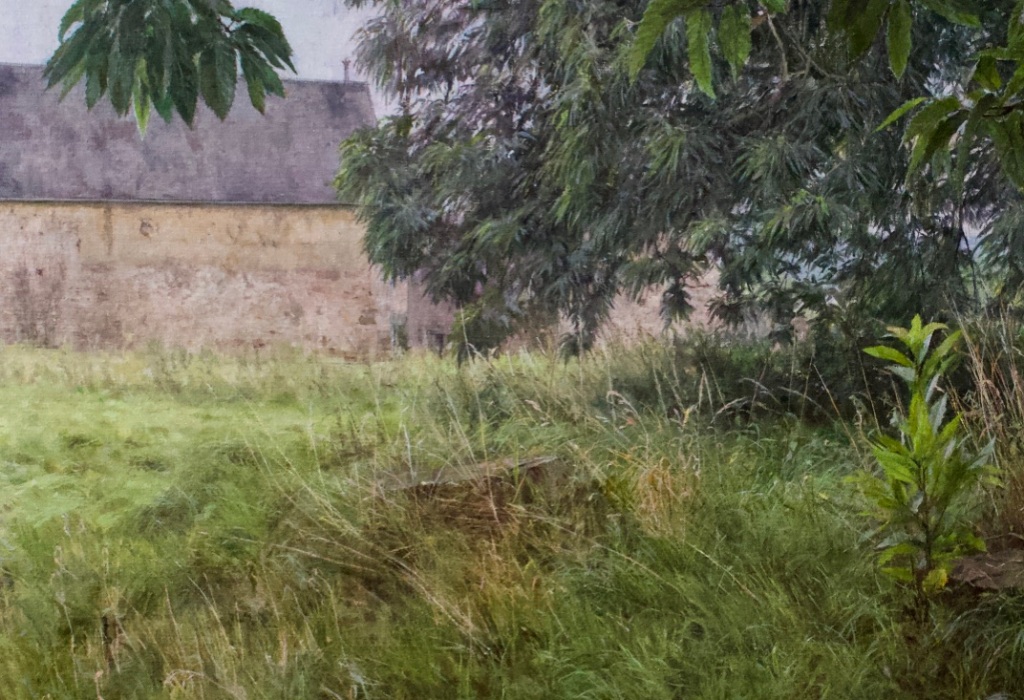
To view, please click on the images in the following galleries:









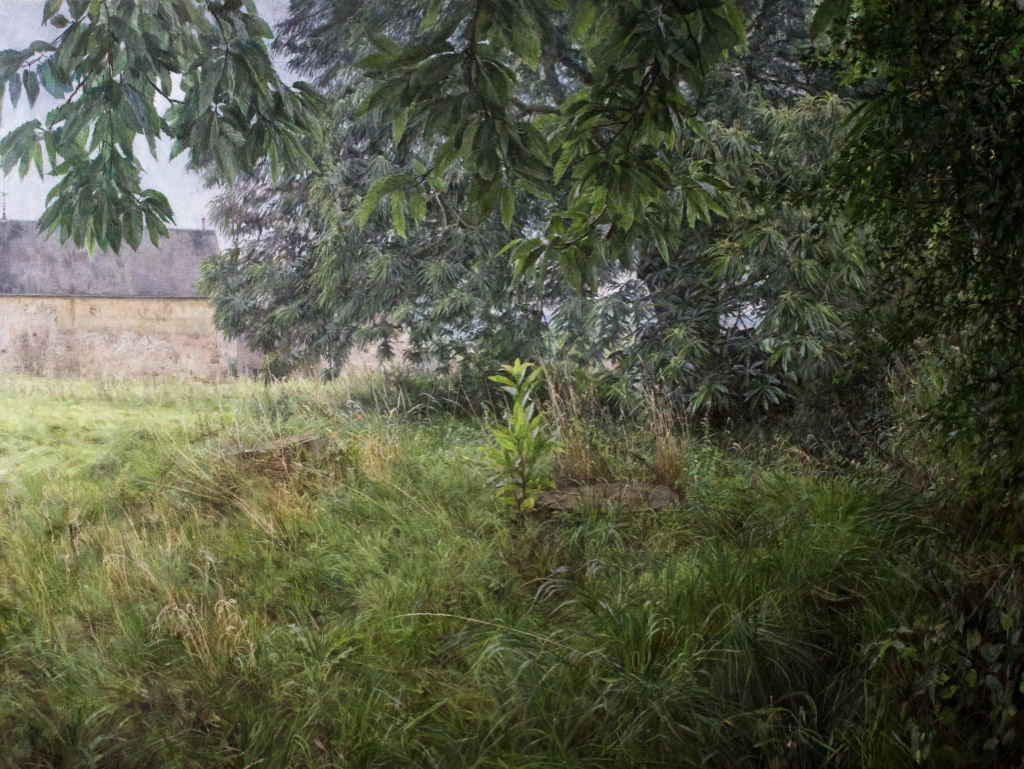
As I worked on my canvas, André took numerous photos. He also set to work on an installation which developed in parallel to the painting, using sink-plungers, ‘debouchoirs’ – ‘unblockers’ as the French call them. His work advanced – or retreated – to a similar timescale as the painting. I felt the painting becoming problematic, and continued working on it beyond the timescale both of its initial conception, and of the summer event, even returning to it in December.


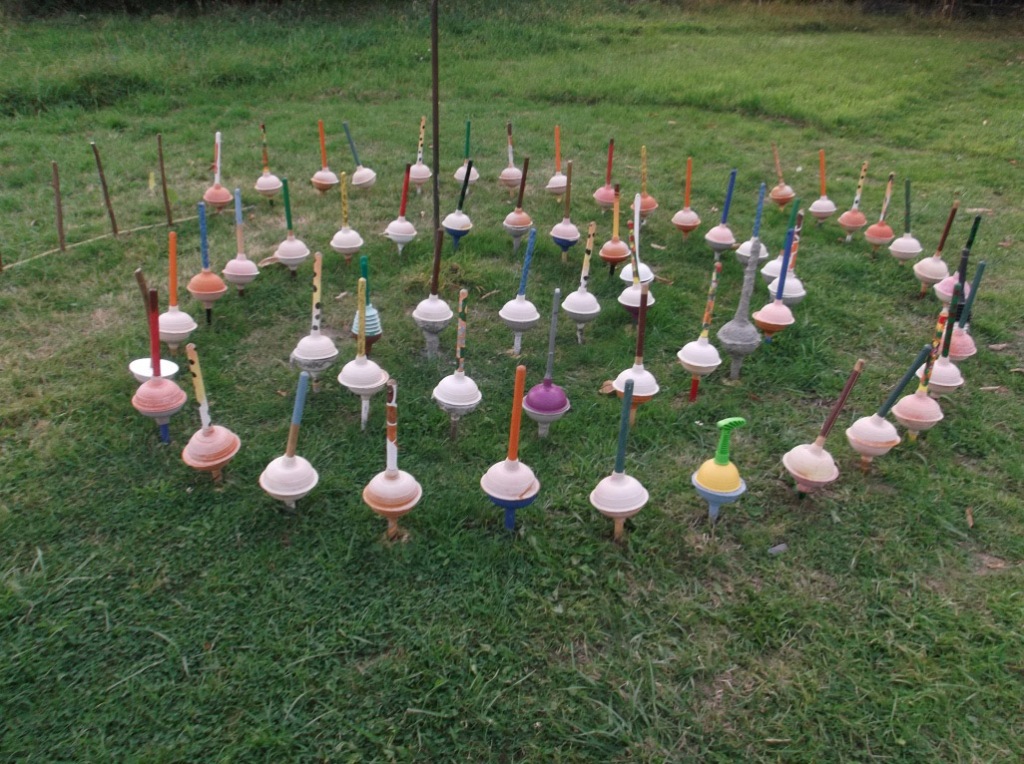




Finally I organised an exhibition at my place in Regnéville sur mer so that people could see the ‘finished’ work, with participation and a further installation by André.
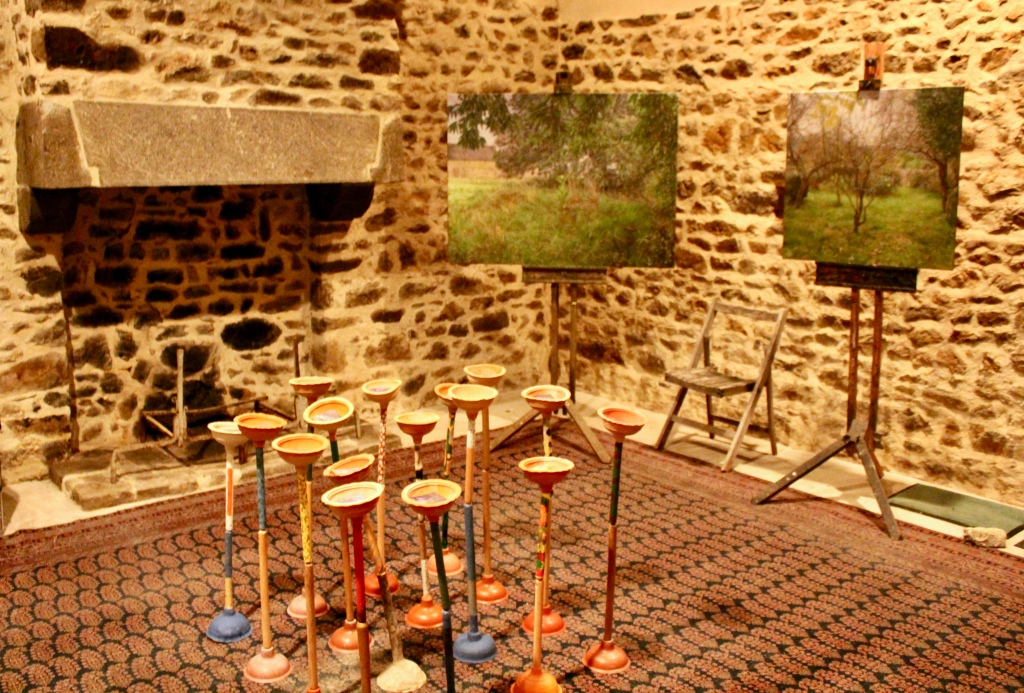
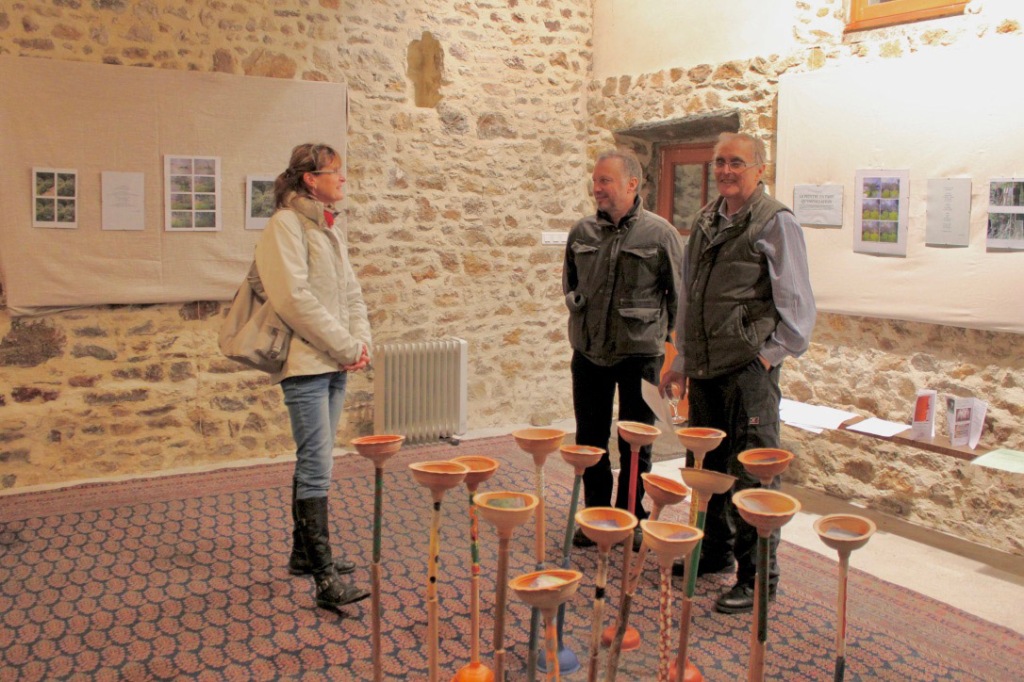
LE PEINTRE EN TANT QU’INSTALLATION
Cette exposition résulte d’ ‘À travers champs 2’ l’événement estival d’art organisé par André et Arsor – une association d’artistes de même sensibilité.
J’ai été ravi quand André m’a demandé de participer en tant qu’exposition vivante parce que je savais que ce serait mettre l’accent sur l’évolution, l’aspect temporel de ma peinture plutôt que sur la toile finie comme objet d’art ou marchandise.
Quant à savoir pourquoi un peintre apparemment traditionnel devrait être affiché aux côtés d’artistes conceptuels, c’est tout à fait compatible avec la philosophie de Arsor, qui est de promouvoir les liens entre les artistes et la société en général, et de libérer la créativité dans toutes sortes de contextes à travers ce champ. Dans l’œuvre d’André, un objet du quotidien comme un débouchoir, qu’il considère comme représentant de l’humanité, est un symbole approprié pour débloquer les canaux de la compréhension et de l’expression.
Pourquoi dois-je peindre les plantes? Parce que la photosynthèse est la base de la culture. (Les artistes sont autorisés à faire des déclarations non étayées de ce genre!)
De nombreux peintres, y compris moi-même dans le passé, ont travaillé dans le détachement olympien et intemporel d’un studio. Dans ce lieu, vous pouvez travailler sur une toile, la mettre de côté et y revenir parfois des années plus tard, ou être occupé par plusieurs œuvres dans l’espace d’une journée. Mais la plupart de ma carrière de peintre a été consacrée à travailler presque exclusivement dehors par l’observation directe.
L’extérieur est l’inverse du studio: on est engagé dans un emplacement particulier, et soumis aux vicissitudes d’une époque particulière. Le temps devient une partie intégrante de l’objet de la peinture, et ses exigences influencent profondément la technique et son approche globale.
J’expose cette peinture comme un pièce d’art qui fait partie d’un processus continu. La toile est le fruit d’une longue expérience dans un cadre particulier du cadre espace-temps, mais elle incarne un passé qui définira également son avenir.
JOHN PEARCE, Décembre 2012, La Trancardière
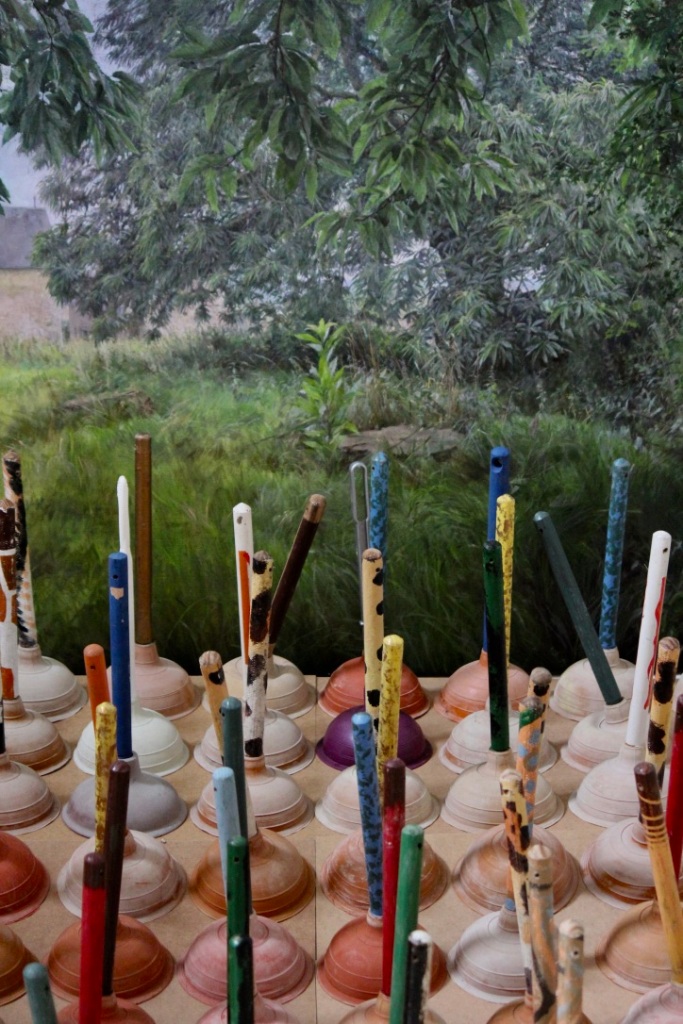
Some keys to this image, (translated from André’s original text):
This is an image from 2012, following “à travers champs 2”, the event organised by ARSOR (the name implies ‘art out’) involving encounters between many artists.
It is a partial view of a canvas and sink-plungers.
It is, at one and the same time, a confrontation between two approaches; two people; a meeting, a scenario, game, exchange, and dialogue.
The background is a painting by John PEARCE in progress, temporarily stored in my studio. One peculiarity of John PEARCE’s painting is the duration of its realisation. This canvas demanded 112 days working directly from his subject, over a period of 6 months.
In the extension of its foreground space, I placed the sink-plungers on the ground, positioned as close as possible to completely cover the surface. One of the peculiarities of my job as an artist is to use numbers of these objects in ephemeral installations.
This relationship between the canvas and the plungers results in this piece, of which only a few images will preserve traces.


Original text by André:
Quelques clefs sur cette image :
- C’est une image de 2012, un après « à travers champs 2 » (Cette manifestation organisée par ARSOR qui fut la rencontre de nombreux artistes).
- C’est une vue partielle entre une toile et des débouchoirs.
- Elle est à la fois, rencontre, confrontation, mise en situation, jeu, échange, dialogue, entre 2 approches, 2 personnes.
- Le fond est une toile de John PEARCE en cours de réalisation, stockée momentanément dans mon atelier à cet endroit précis (une des particularités de la peinture de John PEARCE est sa durée de réalisation, cette toile lui a demandé 112 jours de labeur face à son sujet, sur une période de 6 mois).
- Au premier plan, dans son prolongement, j’ai placé au sol des débouchoirs, ils sont positionnés au plus près et ils recouvrent totalement la surface (c’est une des particularités de mon boulot, que d’utiliser cet objet en nombre dans des installations éphémères).
- Cette mise en situation entre la toile et les débouchoirs donnent cette pièce, dont seules quelques images en garderont la trace.
The poetry workshop – ‘Les plumes de la Sienne’ – also took part in the event. Those who wrote about my painting admirably grasped the process, so I used two of their texts in this video:
